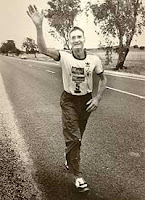 There has been a lot of hype lately about the world “going green.” All of a sudden everyone is very concerned with saving our planet and restoring the environment to the Eden of yore. But there’s another color we now should consider with just as much fervor and zeal: blue.
There has been a lot of hype lately about the world “going green.” All of a sudden everyone is very concerned with saving our planet and restoring the environment to the Eden of yore. But there’s another color we now should consider with just as much fervor and zeal: blue.Recently I discovered what I guess isn’t such a recent discovery, but alas, one overlooked by the public eye. Blue Zones, or the marketing ploy of a guy, Dan Buettner, trying to sell books, are places in the world where people are 10% more likely to live to be 100 years old. 100 years old! And these people aren’t setting dates and times to jog in Central Park, nor are they going to an expensive and crowded gym. They’re simply living their lives as those before them had and as those after will. So what’s the secret?
Buettner lays it out in 5 loosely defined categories: diet, work, community, purpose, and environment. The right combination of a few of these factors and you’ve got yourself on the longest path possible towards eternity. The nature of these categories is what really intrigues me. Some, like diet and environment, are fairly scientific. With the right ingredients, for instance the herbal teas of Okinawa or the unbelievably anti-oxidant rich wine in Sardinia, you can keep your body clean and fit, and thus extend its usage period. This fits well into the American mindset, doesn’t it? No matter what, if you have these set things you will always achieve a certain outcome, given the correct mixture. 1 plus 1 ALWAYS equals 2. It’s as simple as that.
The other elements are somewhat more circumstantial. The kind of work people in these Blue Zones are doing is manual type labor. Most are farmers in mountainous regions, walking miles every day, performing low intensity exercises while maintaining a sense of purpose. All of these things come “naturally” to people in the region. There aren’t any crowded bus rides or polluted street cars. People use those things we in the Segway-era have forgotten about: legs. And in doing so, they decrease their chances of heart disease and high blood pressure.
With increased vitality comes an increased sense of purpose and activity within the community. People living in Blue Zones tend to be connected with the others living around them. Unlike here, where people are senior citizens by 65 and are done, worn out, too old to be of use, and shipped off to nursing homes, elderly people in Blue Zones remain vital to their communities’ culture. The bridge between young and old barely even exists.
Recently I read an article about a related story from which I’ve found new words to live by. In Australia there’s a competition unlike any other. A race that’s longer, more grueling, and frankly unfathomable for the normal human being. (Of course, right? I mean, it’s Australia. What else would you expect from the land down under?) It’s called the Westfield ultra-marathon and it’s a 543-mile trek from Sydney to Melbourne. Most of the 150 entrants are, as you might assume young adults in prime shape, geared up and ready to go; their bodies are the culminations of 20-some-odd years of intense training.
 In 1983 however, a 61-year-old man, aptly named Cliff Young, entered the race and stunned the world when he finished first and set a record time by 2 days. Young, a sheep farmer from Victoria, Australia, said he trained by working through the nights without sleep. His advice for others and my new words by which I live: “No matter what you do, you have to keep moving. If you don’t wear out, you rust out.”
In 1983 however, a 61-year-old man, aptly named Cliff Young, entered the race and stunned the world when he finished first and set a record time by 2 days. Young, a sheep farmer from Victoria, Australia, said he trained by working through the nights without sleep. His advice for others and my new words by which I live: “No matter what you do, you have to keep moving. If you don’t wear out, you rust out.”I think Buettner and the Blue Zone people would agree. It’s all about remaining active. Activity stimulates the body as well as the mind. When you’re active, you have purpose. When you have purpose, your attitude toward life is positive. When you stay positive, you stay healthy. And when you stay healthy, you live longer.
Whether or not I will live to be 100 remains a moot mystery. But what I can say now is that along with going green, (as I register for paperless statements from my Visa card…) I’m also dedicated to going blue. Anyone interested in coming with?


I like where you're heads at, not sure if you've read Outliers by Malcolm Gladwell but part of his book talks about something very similar to Blue Zones, its interesting stuff
ReplyDeleteNo I haven't read that one. I looked it up though and it seems really interesting. I'll definitely give it a look.
ReplyDeleteI'm coming with you.
ReplyDelete